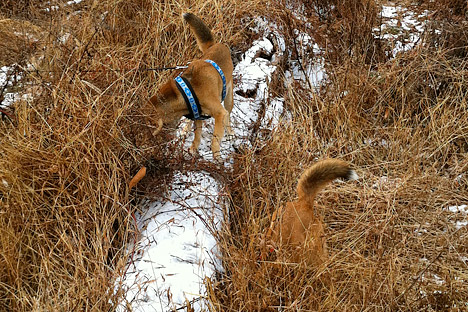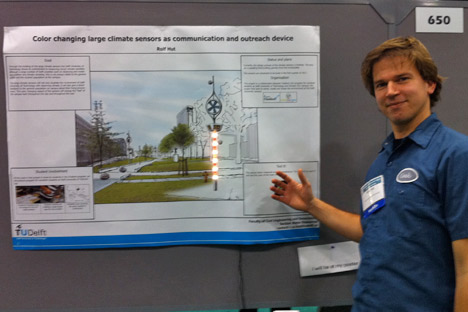I got back from AGU last Saturday, picked up the pups from the kennel, and now I’m getting things together here so I can go on vacation right after Christmas.

As always it’s an overwhelming conference—there’s probably 1,000 posters on the floor at any given time, and at least ten simultaneous sessions. I got some very good ideas wandering through the posters (a map of ice flow speed for all of Antarctica, research on a paleo lake in Kenya, and a global dataset of limiting factors for tree growth being highlights) that I’ll hopefully be working on in the New Year. Tuesday’s special session on communicating climate change was also worthwhile (and packed). I think both my talks went pretty well, even if I can’t pronounce Eyjafjallajökull—despite professional help from a native Icelandic speaker. One conclusion we came to in the visualization session: it would be helpful for AGU to start promoting good visualization techniques. I plan on following up on that, hopefully I’ll have more to say soon.
A few words of advice for poster presenters (I originally planned on showing some examples of good and bad design, but chickened out). White space is good: try not to jam your poster full of every last detail of your research. Do not use Comic Sans (avoid it on slides, too). Seriously. Your research may be groundbreaking, but it’s hard for me to take you seriously if you try to be cute. Especially since the new Microsoft typefaces that ship with Vista, Windows 7, and recent versions of Office are very, very good. Make your graphics big. Avoid the rainbow palette. (I’ll have more to say about this—a lot more—soon. It was a big part of my Eyjafjallajökull talk.) Print up a one-page summary to distribute. Include a conclusion, written for non-experts. Your poster will be up all day, you’ll only be there for an hour or two. Finally: if you can figure out a way to add multimedia, do it. Rolf Hut of the Delft University of Technology had an amazing, temperature-sensing interactive LED display:





Nice synopsis. What is AGU?
here’s one person who would like to hear what “more you have to say” on good visualisation technique – even though i’m a ‘layman’, i do get to see a lot of ppts, with graphic representation of language-related analytic phenomena, so it is an interest area.
of course, tips on presenting graphic representation is also welcome for my own presentations which are usually over-stuffed.
currently enjoying tufte’s latest tome, ‘beautiful evidence’.
Thanks for your honest evaluation of the (fall) AGU conference. I attended the (smaller) Ocean Sciences meeting last year and was quite happy with that size. I would enjoy hearing more open critiques of posters as that is something I just blogged about! May I share your blog?
Sue: AGU is the American Geophysical Union. If I was writing a blog about good written communication, I’d point out that acronyms obscure information for the uninitiated, and should be avoided if possible, and spelled out if not. But since I’m writing a blog about visual communication, I’ll give myself a free pass, at least just this once.
Eldon: Tufte is essential reading, I hope you’re enjoying his books.
Heather: Feel free to share the blog. Hopefully I’ll keep it better updated in 2011 (not that I’m out to a good start).